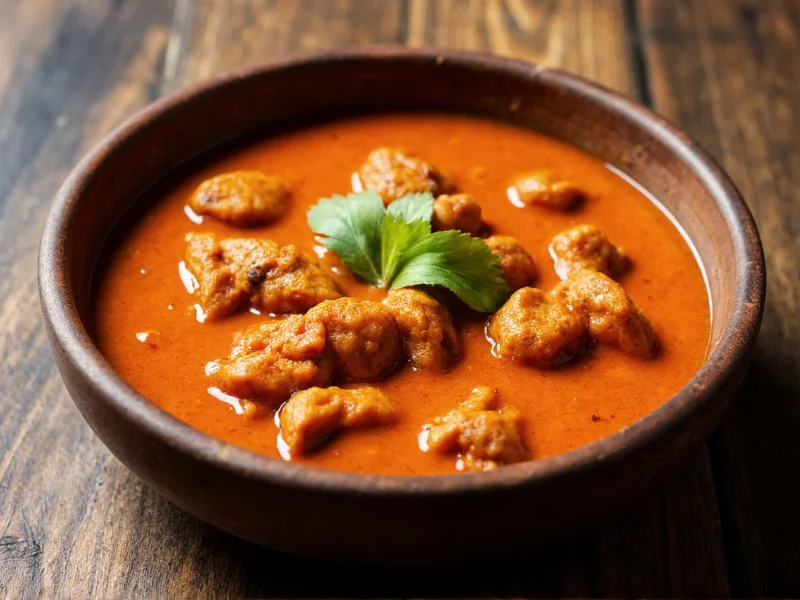When exploring is curry spicy hot, it's essential to understand that "curry" refers not to a single spice but to a diverse category of dishes originating from South Asia and adapted globally. The term encompasses countless regional variations, each with distinct flavor profiles and heat levels. This culinary diversity explains why the answer to is all curry spicy is definitively no.
Understanding Curry: Beyond the Spice Myth
Curry fundamentally describes a method of cooking—typically involving simmering ingredients in a sauce—rather than a specific spice blend. The confusion often arises because Western grocery stores sell "curry powder," which frequently contains chili peppers. However, traditional Indian curry powders used in regions like Kerala or Goa may contain little to no chili, relying instead on turmeric, cumin, and coriander for flavor.
Professional chefs and culinary historians note that many historic curry recipes were developed for royal courts where extreme heat was undesirable. As food anthropologist Dr. Rukmini Srinivas explains, "The notion that curry must be spicy is a colonial-era simplification. Traditional South Indian sambhar or Sri Lankan lunu miris showcase how regional variations prioritize complex flavor balance over pure heat."
Regional Curry Variations and Heat Levels
Understanding why is curry hot in some preparations requires examining global interpretations:
| Curry Type | Origin | Typical Heat Level | Key Heat Components |
|---|---|---|---|
| Japanese Katsu Curry | Japan | Mild (1/10) | Rarely contains chilies; sweet apple notes |
| British Mild Curry | United Kingdom | Mild (2/10) | Minimal chili; heavy on turmeric |
| Thai Green Curry | Thailand | Hot (7/10) | Fresh green chilies, bird's eye peppers |
| Goan Vindaloo | India | Very Hot (9/10) | Kashmiri chilies, black pepper |
| Sri Lankan Fish Curry | Sri Lanka | Moderate (5/10) | Curry leaves, minimal chili paste |
What Makes Curry Spicy: The Science Behind the Heat
The spiciness in curry comes primarily from capsaicin—the compound in chili peppers—not from curry leaves or traditional curry spices. When examining what makes curry spicy, consider these factors:
- Chili variety: Bird's eye chilies (common in Thai curry) contain 50-100x more capsaicin than bell peppers
- Preparation method: Toasting chilies before grinding intensifies heat
- Cooking duration: Longer simmering distributes but doesn't eliminate capsaicin
- Fat content: Coconut milk in Thai curries temporarily masks heat perception
Food scientists at the Institute of Food Technologists confirm that curry spice level explained simply comes down to chili inclusion. "A chef can make 'curry' with zero heat by omitting chilies entirely," states Dr. Elena Rodriguez. "The base spices—turmeric, cumin, coriander—contribute earthiness and aroma but no actual heat."
Controlling Curry Heat: Practical Guidance
Whether you're wondering how to make curry less spicy or seeking authentic heat levels, these techniques help manage spiciness:
- Start mild: Use curry powder without added chilies or begin with 1/4 teaspoon of chili paste
- Balance with dairy: Stir in yogurt or coconut milk to counteract capsaicin
- Add sweetness: A teaspoon of sugar or fruit (mango, apple) neutralizes heat perception
- Remove seeds: Discard chili seeds and membranes where most capsaicin concentrates
- Adjust at serving: Offer chili oil separately for customization
Professional chefs emphasize that authentic curry-making focuses on flavor layering rather than maximum heat. "The best curries create a symphony of tastes where heat plays just one instrument," explains Chef Arjun Patel of Mumbai's Masala Library. "Asking is Japanese curry spicy misses the point—Japanese curry celebrates umami and sweetness, not burn."
Common Misconceptions About Curry Heat
Several myths persist about curry and spiciness:
- Myth: Yellow curry = mild, red curry = hot
Fact: Color comes from turmeric (yellow) or tomatoes (red), not necessarily heat level - Myth: All Indian curries are extremely spicy
Fact: Many South Indian vegetarian curries use minimal chilies - Myth: Curry powder determines spiciness
Fact: Commercial blends vary wildly; homemade versions control heat precisely
Understanding these distinctions helps answer mild curry vs spicy curry questions accurately. The global curry landscape offers everything from completely mild British curry house specialties to intensely hot regional Indian preparations.
Conclusion: Embracing Curry's Diversity
The question is curry spicy hot reflects a common oversimplification of a complex culinary tradition. Authentic curry experiences span the entire flavor spectrum, with heat being just one optional element. By recognizing regional variations and preparation techniques, home cooks and diners can appreciate curry's true diversity beyond the spicy stereotype. Whether exploring Thai curry heat levels or seeking mild Japanese interpretations, the key is understanding that curry's essence lies in its aromatic complexity—not mandatory heat.
Frequently Asked Questions
Is all curry supposed to be spicy?
No, not all curry is spicy. Many traditional curries like Japanese katsu curry, British mild curry, and certain South Indian vegetarian dishes are intentionally mild. Spiciness depends on regional recipes and added chili peppers, not the curry base itself.
What makes some curries spicy while others are mild?
The spiciness comes primarily from chili peppers added during preparation. Mild curries use little to no chilies, while hot varieties incorporate fresh or dried chilies. Curry leaves, turmeric, and other base spices contribute flavor but not heat.
Can I make curry without any heat?
Yes, you can create completely mild curry by omitting chili peppers and hot spices. Traditional recipes like Kerala fish molee or British chicken korma achieve rich flavor through coconut milk, nuts, and aromatic spices without any heat.
Why do people think all curry is spicy?
This misconception stems from Western interpretations where "curry powder" often contains chili, and restaurants sometimes overemphasize heat for dramatic effect. Many people haven't experienced the wide range of mild traditional curries from various cultures.
How can I reduce spiciness in curry after it's too hot?
Add dairy (yogurt or coconut milk), sweetness (sugar or fruit), or acid (lemon juice). These ingredients help counteract capsaicin. You can also dilute with more base liquid or serve with cooling sides like raita. Remember that once added, you can't remove chili heat completely.











 浙公网安备
33010002000092号
浙公网安备
33010002000092号 浙B2-20120091-4
浙B2-20120091-4